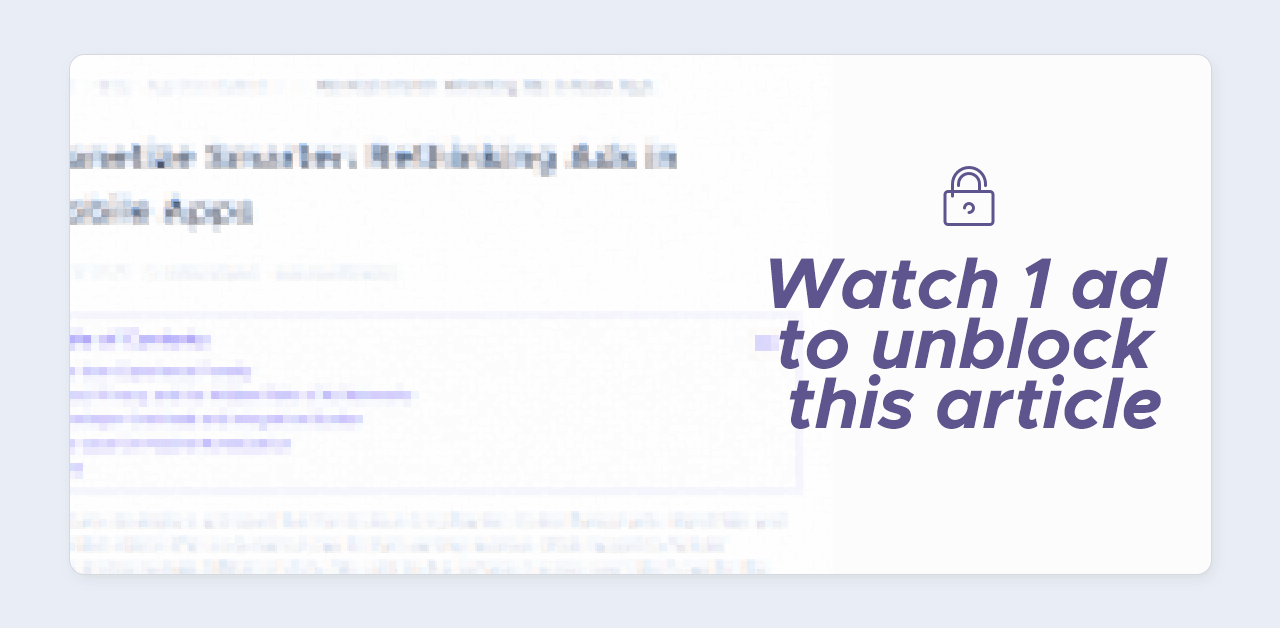For many developers, ads seem like the obvious monetization choice. Banner ads, interstitials, and rewarded videos offer a low-barrier way to start earning revenue, often backed by familiar platforms like Google AdMob or Unity Ads. And on the surface, it works: users don’t pay for the app, and developers still make money.
But over time, this model reveals its cracks. Users grow tired of interruptions. Engagement drops. Ratings decline. Developers spend more time managing ad behavior and complaints than shipping product improvements. The real cost of ads isn’t just the screen space they occupy – it’s the long-term impact they have on retention, reputation, and control.
The User Experience Penalty
Ads don’t just take up screen space – they demand attention. Every banner, popup, and unskippable video chips away at the experience users came for. What starts as a free app quickly feels like a trade-off: watch this ad, wait five seconds, close the overlay, repeat.
This friction adds up. Users abandon tasks mid-flow. Games become less immersive. Utility apps feel bloated. Even rewarded ads – popular for offering in-game perks – can break momentum and add clutter. Worse still, users often view these ads as invasive or exploitative, especially when frequency increases to boost revenue.
Over time, this undermines loyalty. Reviews mention “too many ads.” Word of mouth drops off. And your most valuable users – the ones who stick around – might leave simply because the experience feels compromised. That’s the user experience penalty of ad-based monetization. And in a competitive app ecosystem, it can cost far more than it earns.
Trust, Privacy, and the Hidden Risks of Ad Networks
Every time an ad loads in your app, you’re not just showing content – you’re inviting in a third party. Most ad networks operate with tracking pixels, behavioral profiling, and user fingerprinting techniques to target ads more effectively. But to your users, it’s not the ad network that’s responsible – it’s your app.
This can erode trust fast. Users are increasingly sensitive to privacy concerns, especially as regulations like GDPR and CCPA spotlight data transparency. If users feel like they’re being watched, profiled, or unknowingly sharing data, they won’t just stop using the app – they might flag it, leave negative reviews, or report it to app stores.
Even developers with the best intentions can get caught in this privacy dragnet. You may not control which ad is shown, what it tracks, or where the data goes – but you are held accountable for it.
Developer Overhead and Integration Burden
Monetizing with ads isn’t plug-and-play. While ad networks promise fast setup, the reality often involves significant ongoing developer effort – from integration to maintenance to troubleshooting.
Each ad SDK you embed adds to your codebase complexity. You need to manage ad placements, deal with conflicting UI elements, and optimize load times to avoid performance slowdowns. On top of that, app store policies change regularly – and non-compliant ad behavior can result in warnings, takedowns, or loss of monetization rights.
Then there’s user support. Complaints about intrusive ads, broken links, or inappropriate content often fall to your team, even if the issue lies with the ad provider. What should be a source of revenue becomes a source of stress – especially for smaller teams with limited engineering bandwidth.
In the end, ad monetization isn’t free. It demands technical upkeep, QA cycles, and constant vigilance – costs that silently eat into your margins and focus.
The Case for Passive Monetization
If ads come with friction, complexity, and trust concerns, what’s the alternative? For many developers, the answer lies in passive monetization – models that generate revenue in the background, without disrupting the user experience.
Passive monetization solutions like Infatica SDK enable this shift. Instead of showing ads or locking features behind paywalls, the app monetizes through user participation in a secure peer-to-business (P2B) network. This means users contribute small amounts of unused bandwidth while the app is running – with full transparency and consent. There are several key advantages:
- No ads, no popups, no interruptions
- Does not collect personal data or track users
- Secured by Bitdefender to block malicious traffic and phishing attempts
- ISO/IEC 27001:2022 certified for top-tier information security
- Lightweight and performance-friendly, with minimal code impact
- Compliant with GDPR, CCPA, and major app store policies
- Full user consent and transparency required before activation
Infatica SDK is designed for developers who want to monetize ethically, securely, and without degrading the user experience. With Infatica SDK, developers gain a flexible revenue stream – one that complements existing monetization models, enhances app trust, and keeps users engaged. It’s monetization done differently – and done right.
Frequently Asked Questions
How does Infatica SDK generate revenue without showing ads?
Infatica SDK enables your app to earn income by joining a secure peer-to-business (P2B) network. It monetizes through background bandwidth sharing – with full user consent and no impact on app flow.
Will users notice or be affected by the SDK?
No. The SDK operates silently in the background, with no ads, pop-ups, or performance disruption. It’s designed to be lightweight and completely non-intrusive to the user experience.
Is the SDK safe and privacy-compliant?
Yes. Infatica SDK is ISO/IEC 27001:2022 certified, GDPR/CCPA compliant, and protected by Bitdefender. It does not collect personal data or track user behavior.
Can I use Infatica SDK alongside ads or IAPs?
Absolutely. The SDK is compatible with most monetization models and works best as a supplemental revenue stream, especially for free apps with broad user bases.
What types of apps benefit most from Infatica SDK?
Utility, productivity, and tool apps – or any app where ads could disrupt the user experience – are ideal. It’s also effective for monetizing users in regions with low ad revenue.
